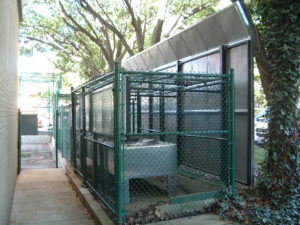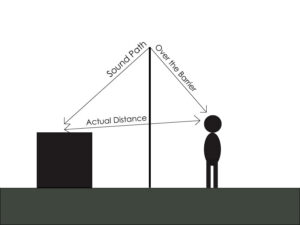AVANT’s Guide to Acoustical Barriers
Acoustical barriers can reduce noise from outside sources, such as roadways and railways, or from mechanical equipment, such as HVAC systems or vacuums. The following guide will discuss the requirements for effective sound barriers.
Construction of Acoustical Barriers

This acoustical barrier helps mitigate the noise disturbance of a building’s air conditioner units.
Barriers constructed with a high mass will have a high transmission loss. In other words, the heavier the material, the better it will work! High-mass barriers typically include prefabricated metal panels or concrete masonry units. To improve the aesthetics, these barriers can sometimes include a facing material.
The acoustical barriers must be continuous with no gaps between panels or between the ground and the barrier. Barriers around rooftop equipment can sometimes be the exception to this requirement. These may not need to extend all the way down to the roof if a parapet around the building can effectively act as the lower portion of the barrier.
Placement of Acoustical Barriers

A barrier increases the distance sound must travel.
In addition to being well constructed, acoustical barriers should block the line of sight to the noise. If you can see it, you can hear it! Keep in mind this includes both the horizontal and vertical planes.
Furthermore, effective barriers typically extend well past the point where the line of sight is interrupted. The attenuation from barriers relates to the difference in distance of the path sound travels between source and receiver and the actual distance between source and receiver. In general, the greater the distance sound must travel around the barrier, the less you’ll hear of that sound!
Face Material for Barriers
In some cases, adding absorptive material to the face of the barrier may be appropriate. This can help prevent noise reflections. For example, a barrier around a mechanical unit outside a building naturally tends to reflect sound back toward the building. However, adding absorption to the inner face of the barrier reduces the amount of noise reflected.
Next Steps
Now that you know the basics, have an informed discussion with your acoustical consultant about barriers for your project. Acoustical consultants will analyze the geometry of the situation, and determine the octave band attenuation that a barrier can provide.
Contact AVANT ACOUSTICS for more details about how we can help!
Download This Guide
This post was authored by AVANT ACOUSTICS Senior Associate, Andrew VonFeldt.


